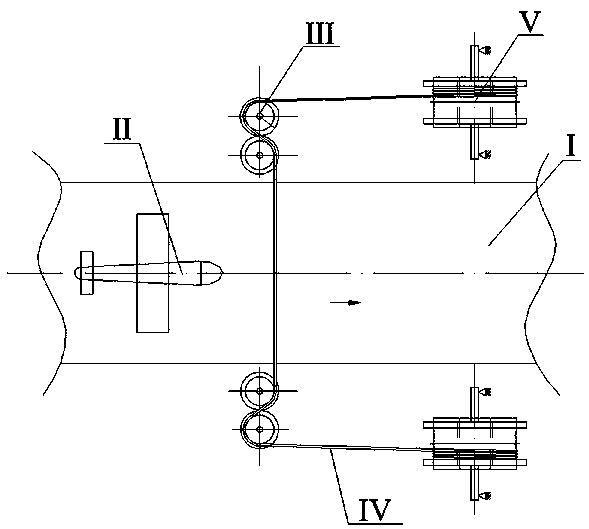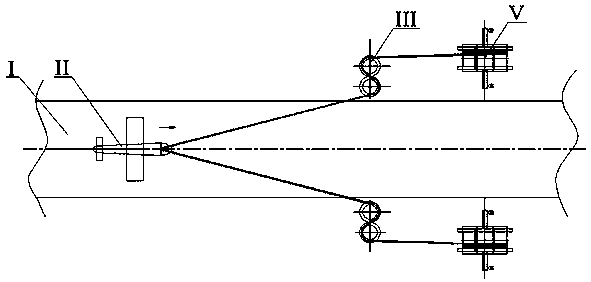Airport power-assisted take-off and landing device dragged by superconducting outer rotor motor
An external rotor motor and superconducting technology, applied in the field of aeronautical engineering, can solve the problems of unrecoverable kinetic energy of aircraft, pollution of surrounding environment, high fuel consumption, etc., and achieve the effect of increasing take-off stability, shortening taxiing distance, and large frictional resistance.
- Summary
- Abstract
- Description
- Claims
- Application Information
AI Technical Summary
Problems solved by technology
Method used
Image
Examples
Embodiment 1
[0032] Such as figure 1 As shown, an airport power-assisted take-off and landing device driven by a superconducting outer rotor motor 6 includes a horizontal stay cable IV, an airport runway I, a fixed pulley assembly III symmetrically arranged on both sides of the airport runway I, and a symmetrically arranged fixed pulley assembly III on both sides of the airport runway I. Reel assembly V on both sides.
[0033] Such as figure 2 As shown, the reel assembly V includes a superconducting outer rotor motor 6, a fixed pressure block 2, a reel 3, a first annular end cover 4, a second annular end cover 4', an inner cylinder 5, a space support 7, a vacuum unit to valve 1 and disc brake 10. The outer circumference of the superconducting outer rotor motor 6 is connected with an inner cylinder 5 through a key, and the reel 3 is concentrically arranged outside the inner cylinder 5, and the first annular end cover 4 is connected between the reel 3 and the inner cylinder 5 through a fi...
Embodiment 2
[0039] Such as Figure 4 As shown, when the aircraft II is landing in the forward direction, the padlock mechanism at the tail end of the aircraft II hangs on the horizontal stay cable IV on the airport runway I, and the horizontal stay cable IV becomes an arresting cable. Under the action of the horizontal stay cable IV, the aircraft The tail end of II sinks and turns into horizontal flight. Aircraft II drives transverse stay cable IV and drags the superconducting outer rotor motors 6 on both sides to rotate to generate electricity. The kinetic energy of aircraft II is recovered and converted into electrical energy, which is clean and environmentally friendly.
Embodiment 3
[0041] Since Airplane II usually takes off and lands in two directions according to the wind direction, when Airplane II takes off in the opposite direction, use the following method: Figure 5 The drag method shown.
PUM
 Login to View More
Login to View More Abstract
Description
Claims
Application Information
 Login to View More
Login to View More - R&D
- Intellectual Property
- Life Sciences
- Materials
- Tech Scout
- Unparalleled Data Quality
- Higher Quality Content
- 60% Fewer Hallucinations
Browse by: Latest US Patents, China's latest patents, Technical Efficacy Thesaurus, Application Domain, Technology Topic, Popular Technical Reports.
© 2025 PatSnap. All rights reserved.Legal|Privacy policy|Modern Slavery Act Transparency Statement|Sitemap|About US| Contact US: help@patsnap.com



